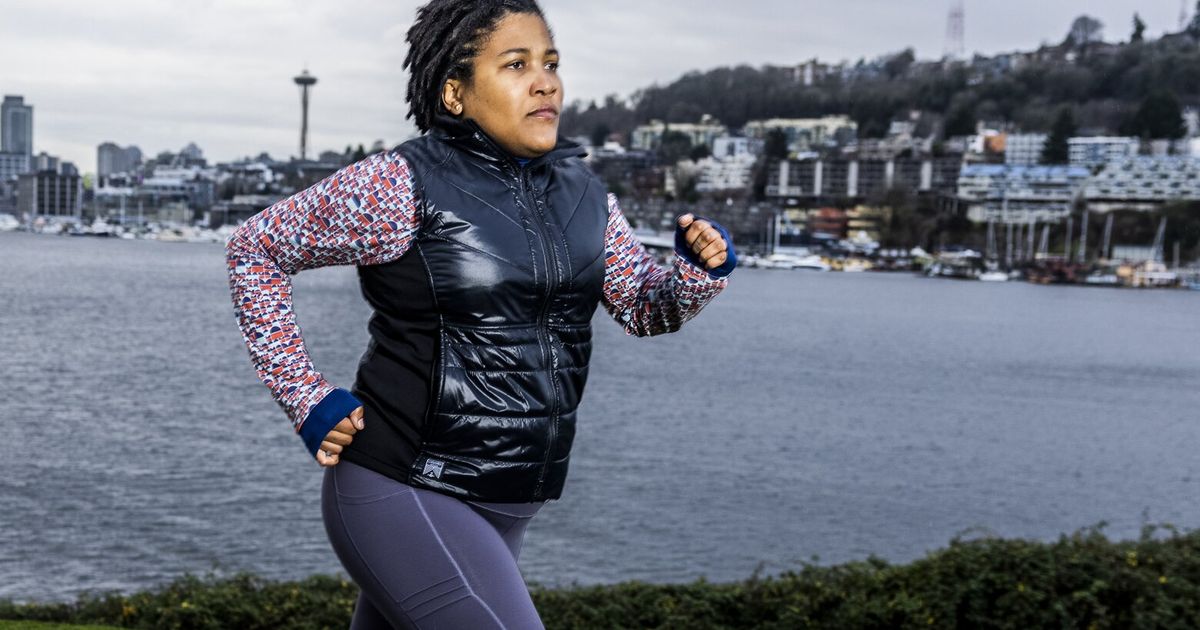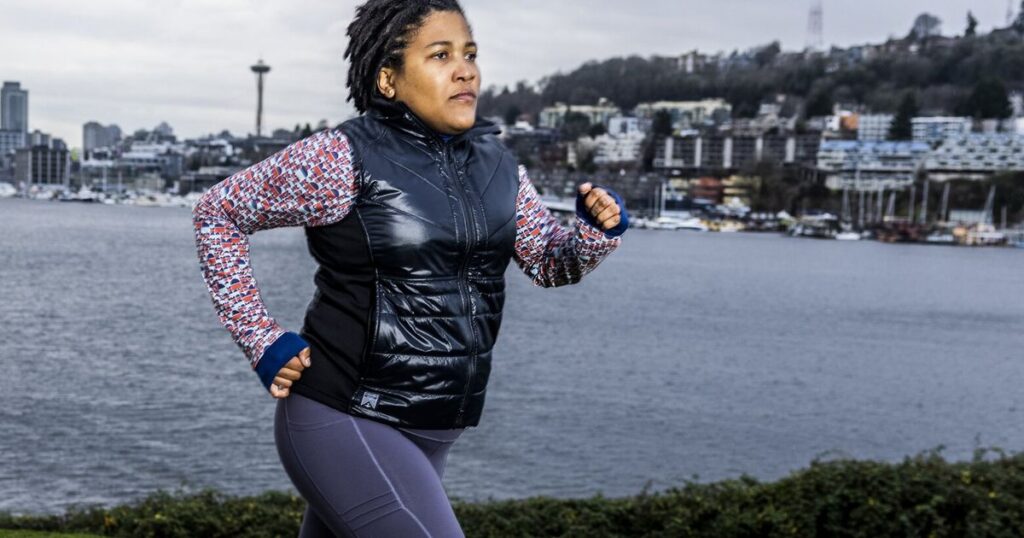
Running helped Alison Mariella Désir emerge from a period of depression. While scrolling Facebook from the couch one day, she came across a friend who was training for a marathon. What struck her was that he was Black. Pigeonholed into track and field in high school, she didn’t realize that Black people ran marathons until that moment.
Six months later, she signed up to train for the San Diego Rock ’n’ Roll Marathon with Team in Training, a step that would change the course of her life and improve her mental and physical health.
It also opened her eyes to the whiteness of distance running. She began to wonder why the supposedly inclusive sport was so devoid of Black people.
In her new memoir, “Running While Black: Finding Freedom in a Sport That Wasn’t Meant for Us,” Désir explores this history of running through a Black perspective. Comparing the history of running as told from a white perspective alongside her own personal experiences, Désir unveils an unknown history of distance running — Black pioneers whose stories were buried due to white supremacy and systemic racism. Her discoveries ignited her desire to call out the inequities and work toward building a more inclusive sport that is truly open to all.
An activist and mental health advocate, Désir is the founder of Harlem Run, Run 4 All Women, and Meaning Thru Movement, as well as co-chair of the Running Industry Diversity Coalition, a Run Happy advocate for Brooks Running, and an athlete adviser for Oiselle.
Désir, who lives in Lake Stevens with her son and husband, spoke with The Seattle Times to discuss what kept her going when no one showed up, what an ideal running culture looks like, and how Seattle-area runners and brands can put in the work to create a more inclusive sport.
Alison will be at Fleet Feet Ballard Dec. 13 for a run and book chat. With a run at 6:30 p.m. and book talk at 7:30.
Your introduction took the reader along for a regular run with you. It allowed me to experience what you feel every time you step outside. I feel some of the things you described on occasion as a woman, but not on every run, and I found it helpful to take those things that I’ve felt and understand that you feel that every single time you run. It was a powerful introduction. Who did you write this book for?
I’m glad that my experience resonated with you. That was my hope. As I write in the introduction, my story is one that will resonate with “anyone who has experienced the harm and powerlessness that comes from not fitting into society’s expectations, anyone who has ever existed in the margins.” That being said, I wrote this book first and foremost for Black people — for us, as the title indicates. I wanted Black people to have our experiences of both joy and fear validated in a running book. Much like every other industry, the publishing industry is extremely white and running books almost entirely center the white male/female perspective. My book is groundbreaking in that it addresses the white supremacy embedded within the running industry and culture and explores how we must navigate it as Black people and what white people can do to begin to dismantle it.
Did you find that you were able to write this book unapologetically or did you struggle with feeling the need to write in a way that would feel less offensive to the white audience, like what you experienced in all of those Zoom meetings when you were working to build the Running Industry Diversity Coalition?
I wrote this unapologetically. There were moments in writing when I knew that a topic would be particularly difficult for white people who had never explored their privilege or understood the concepts of whiteness or white supremacy but I also knew that I would be doing a disservice to everyone if I wasn’t honest and direct. I’m finding that my choice was a wise one and it’s already moving people to greater reflection and action.
It was just you showing up for Harlem Run for nearly six months. What kept you going week after week?
Honestly, it was the support of my mother (who I called every week upset that no one was showing up) and my belief that running would transform other people’s lives, if only they gave it a shot! We as runners become evangelists for our sport — we can’t stop talking about it! On top of that, the deep inequity in who was participating in long distance running was troubling to me. Running had saved my life and I wanted to do everything I could to ensure that more Black people like me could have that transformational experience.
What did it feel like to learn that the distance running movement was started not only by three Black men and the New York Pioneer Club, but also right in the same spot where you were starting your own movement with Harlem Run?
I felt angry and frustrated that I only stumbled across that information, but at the same time, I felt a sense of validation. “Of course, we were there!” In nearly every facet of history, what you find is that the contributions of Black people are erased and ignored and our accolades are attributed to white people. So while it was unsurprising that the same was true in running, it nonetheless was upsetting. I now realize that the work I’ve done with Harlem Run and beyond has all been an extension of their legacy.
If you look at marathon race results since the 1990s, it shows that Black runners are dominating distance running. Ethiopians and Kenyans have dominated the biggest road races, making it virtually impossible for (white) American runners to win in some events, particularly the Boston Marathon. Why do you think that we still don’t have a story of Black people as distance runners, even though they so clearly dominate the sport?
I get a version of this question often and usually start with this — the performances of white long distance runners in the United States are rarely, if ever, compared to the performances of white long distance runners in Finland, let’s say. And yet, the performances of African athletes and Black athletes are expected to mirror one another simply because they are all Black? This is one way that white supremacy operates — allowing for white people to be seen as individuals having unique cultural experiences while lumping all Black people into a single category.
Beyond that, there are numerous reasons why Black Americans don’t have the same performances as Africans. The obstacles for Black Americans are all addressed in my book — white supremacy, redlining, zoning, environmental racism, segregation. It is an unfair and faulty comparison to think that the experience of Black people in the United States in long distance running has anything to do with the experience of Ethiopians and Kenyans in the sport.
How can people let go of the scarcity they might feel by opening up the sport and world in general to be more inclusive. I’m sure the people in power now will feel like there won’t be enough jobs, money, etc. if we look for talent outside of the white scope that has historically held all the power.
Scarcity mindset is ultimately a perspective that comes from white supremacy. It is the idea that resources are limited therefore we must hoard opportunities, resources, access. However, what we know to be the truth is actually the opposite. For example, we know that despite the housing crisis in New York City, there is actually enough housing for nearly everyone who needs it; it is just that capitalism and white supremacy stymie the process.
The truth is, national demographics are shifting and estimates say that within the next 20-30 years, white people will no longer be in the majority. This will mean that the majority of consumers and participants will come from marginalized communities. I read a National Parks report recently that spoke of this shift and warned about the potential negative impact. If outdoor access does not change, park visitation will plummet when demographics shift which does not bode well for the future of national parks conservation and use. I’m hopeful that folks can begin to question their scarcity mindset — recognizing that it is not a truth, but a way of protecting their own privilege.
How can Seattle-area runners and running brands join the movement and put in the work?
I would encourage both groups to start with self awareness and curiosity. Many white people have a difficult time even recognizing how white a space is. Once you have that level of awareness, start asking yourself why that is. What are the obstacles that prevent a Black runner from showing up to your group? Or what is it about the culture of your workplace that makes it inhospitable to Black people? It’s also important that you begin to learn the histories of our people and familiarize yourselves with racial equity work. From there, you can begin making authentic connections with Black folks through collaboration and uplifting our work.
What does an ideal distance running culture look like to you? What are your hopes and dreams for the sport?
An ideal long distance running culture and industry is one that centers belonging — that allows people to show up as their authentic selves. An industry whose workforce mirrors national demographics, rather than concentrates all of the power and decision making ability in the hands of white men. My hope for the sport is that my book opens people’s eyes to what obstacles remain to making running truly open to everyone and that they begin to take intentional action.


More Stories
Harry’s claim he killed 25 in Afghanistan draws anger, worry
Prince Harry’s book exposes grief, war, drugs, family rifts
Tell us how you want to feel and we’ll tell you what to read next